Dogs hold a special place in many American homes, but the joy of pet ownership can be complicated by allergies. For families with allergy sufferers, the quest for a canine companion often leads to “hypoallergenic” breeds. While no dog is entirely allergen-free, certain breeds are known for producing fewer allergens and, crucially for many families, for their minimal shedding. These low-shedding breeds can significantly reduce dander, hair, and other allergens in your home, making family life with a dog much more comfortable. Understanding what truly makes a dog “hypoallergenic” and which breeds best fit a family lifestyle is key to finding your perfect furry friend.
Understanding Non-Shedding and Hypoallergenic Dogs
All dogs, regardless of breed, produce allergens. These allergens are found in their skin (dander), saliva, and urine, not just their hair. However, some dogs are specifically recognized for producing fewer allergens due to their coat type, which also typically means less shedding. These “non-shedding” or “low-shedding” dogs trap loose hair and dander within their curly, wavy, or wire-haired coats, rather than releasing it into the environment. This characteristic makes them a better fit for some individuals with allergies, as there’s less airborne dander to trigger reactions like coughing, itching, or wheezing. It’s important to remember that “hypoallergenic” is a spectrum, and no dog is 100% allergen-free. However, for families seeking a cleaner home environment and potentially fewer allergy symptoms, choosing a breed known for its low-shedding qualities is an excellent starting point.
Top Non-Shedding Dog Breeds Perfect for Families
For families, selecting a dog involves more than just their shedding habits; temperament, energy levels, and trainability are equally important. Here’s a list of non-shedding dog breeds that are also renowned for their family-friendly qualities, making them ideal companions for homes with children and other pets.
1. Poodle
Poodles are famous for their intelligence, elegance, and, most importantly, their low-shedding coats. Available in Standard, Miniature, and Toy sizes, there’s a Poodle to fit almost any family and living situation. Standard Poodles, originally bred for hunting, are robust and playful, while Miniature and Toy Poodles offer the same smarts in a smaller package. Their curly coats, which trap loose hair and dander, require regular grooming to prevent matting but are a boon for allergy sufferers. Poodles are highly trainable and eager to please, making them excellent family pets that thrive on interaction and mental stimulation.
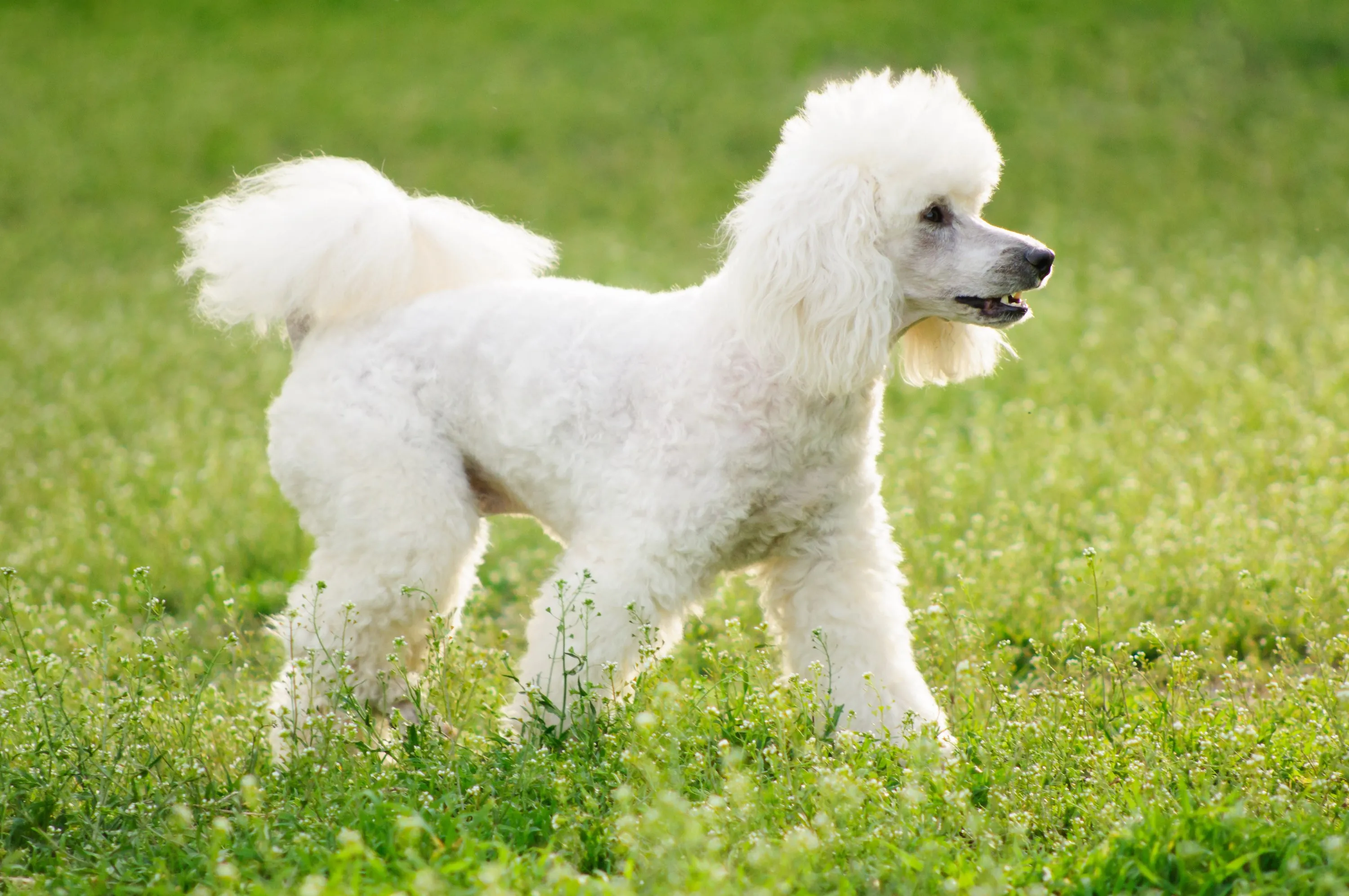 White Poodle walking through lush green grass
White Poodle walking through lush green grass
2. Yorkshire Terrier
These charmingly small dogs, often called Yorkies, boast spunky personalities and affectionate natures, adapting well to various family environments from large houses to cozy apartments. Their fine, silky hair is similar to human hair and sheds minimally, contributing to their hypoallergenic reputation. Yorkshire Terriers are spirited companions who love to be at the center of family life. While they are small, they are also quite confident and can be excellent watchdogs, alerting their families to strangers. Proper socialization and training from a young age are important to ensure they integrate well into a family with children.
3. Shih Tzu
The Shih Tzu is an ancient companion breed known for its luxurious, flowing coat and friendly, outgoing temperament. Despite their thick hair, Shih Tzus are low-shedding, making them a popular choice for families. These small dogs thrive on companionship and are content to be lap dogs, but they also enjoy playful moments with their family members. Their amiable nature makes them generally good with children and other pets. Families should be aware of their brachycephalic (flat-faced) characteristics, which can make them susceptible to overheating and breathing issues, requiring careful management in warm weather.
4. Miniature Schnauzer
Miniature Schnauzers are sturdy, smart, and spirited dogs that fit into many family lifestyles. They are the smallest of the Schnauzer breeds, typically weighing between 10-20 pounds. Their wiry double coat sheds very little, making them a great non-shedding option. Miniature Schnauzers are known for their lively personalities and keen intelligence, making them relatively easy to train. They are devoted to their families and protective, often acting as diligent watchdogs. While small, they are energetic and require at least an hour of daily exercise to stay happy and well-behaved, enjoying family walks or playtime in the yard.
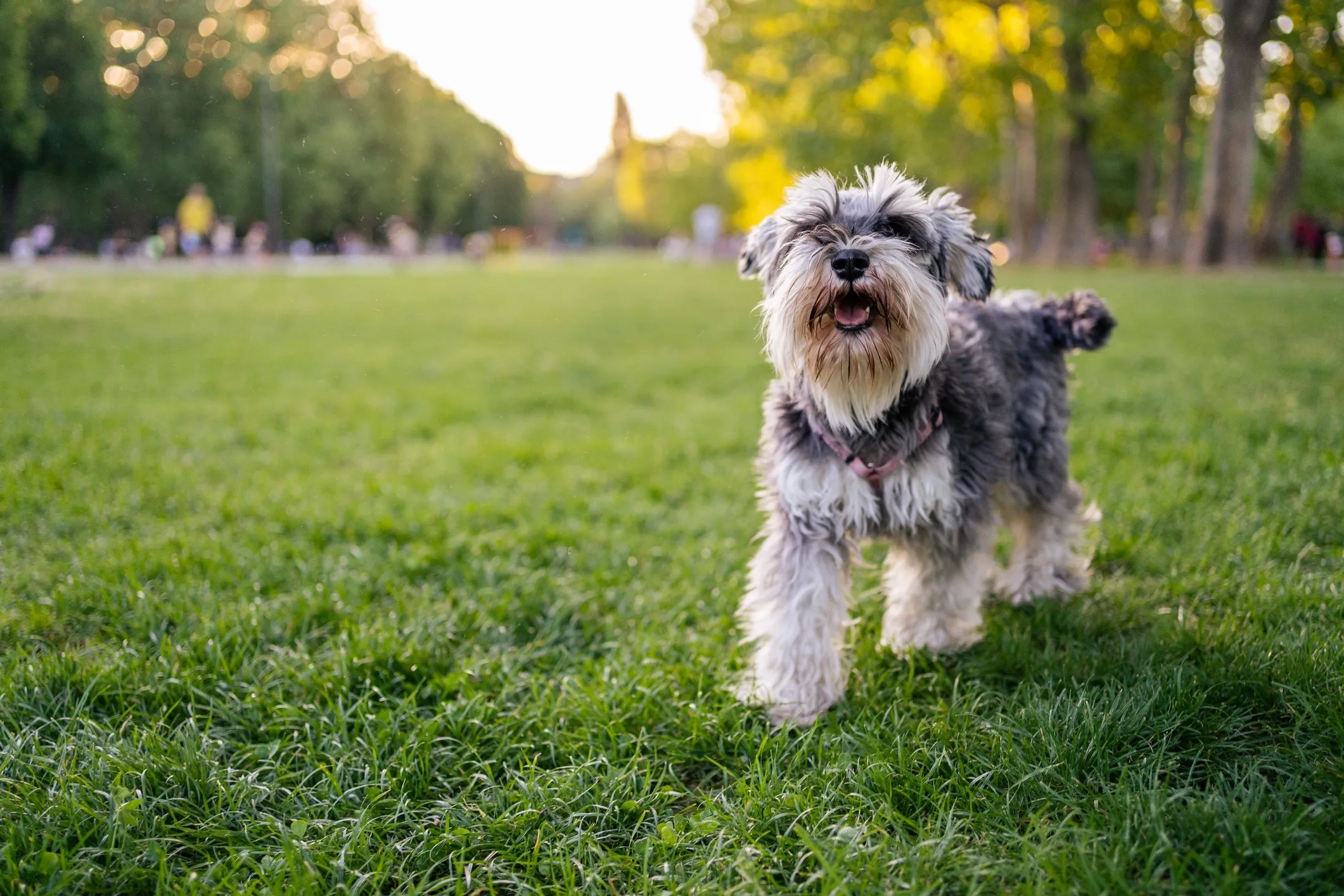 Salt and pepper Miniature Schnauzer wearing a pink harness in a park
Salt and pepper Miniature Schnauzer wearing a pink harness in a park
5. Standard Schnauzer
The Standard Schnauzer offers a larger version of the beloved Miniature Schnauzer’s qualities. Weighing up to 45 pounds, these dogs share the same low-shedding, wiry coat and intelligent, loyal temperament. Standard Schnauzers are robust and energetic, needing plenty of activity to keep them engaged. They excel in activities like long walks, playing fetch, and solving puzzle toys. Their strong protective instincts and playful nature make them wonderful family guardians and companions. For an active family looking for a medium-sized, non-shedding dog, the Standard Schnauzer is an excellent choice.
6. Giant Schnauzer
For families who love large breeds but need a non-shedding option, the Giant Schnauzer is a fantastic choice. Capable of reaching over 27 inches tall and weighing up to 85 pounds, these dogs require significant exercise to be content. They are highly intelligent, courageous, and deeply loyal to their families, making them formidable protectors and loving companions. Their minimal shedding coat requires regular grooming. Giant Schnauzers thrive on activities like long walks, runs, hikes, and vigorous games of fetch, making them ideal for very active families who can provide consistent training and mental stimulation.
7. Bichon Frise
The Bichon Frise is a cheerful, small dog with a cotton-ball-like curly coat that barely sheds. These playful and affectionate pups are highly intelligent and trainable, quickly mastering basics and even fun tricks with positive reinforcement. Their outgoing and loving nature makes them excellent family dogs, typically getting along well with children and other pets. Bichons are social butterflies and thrive on being included in family activities. Their compact size makes them suitable for various living situations, provided they receive enough attention and daily play.
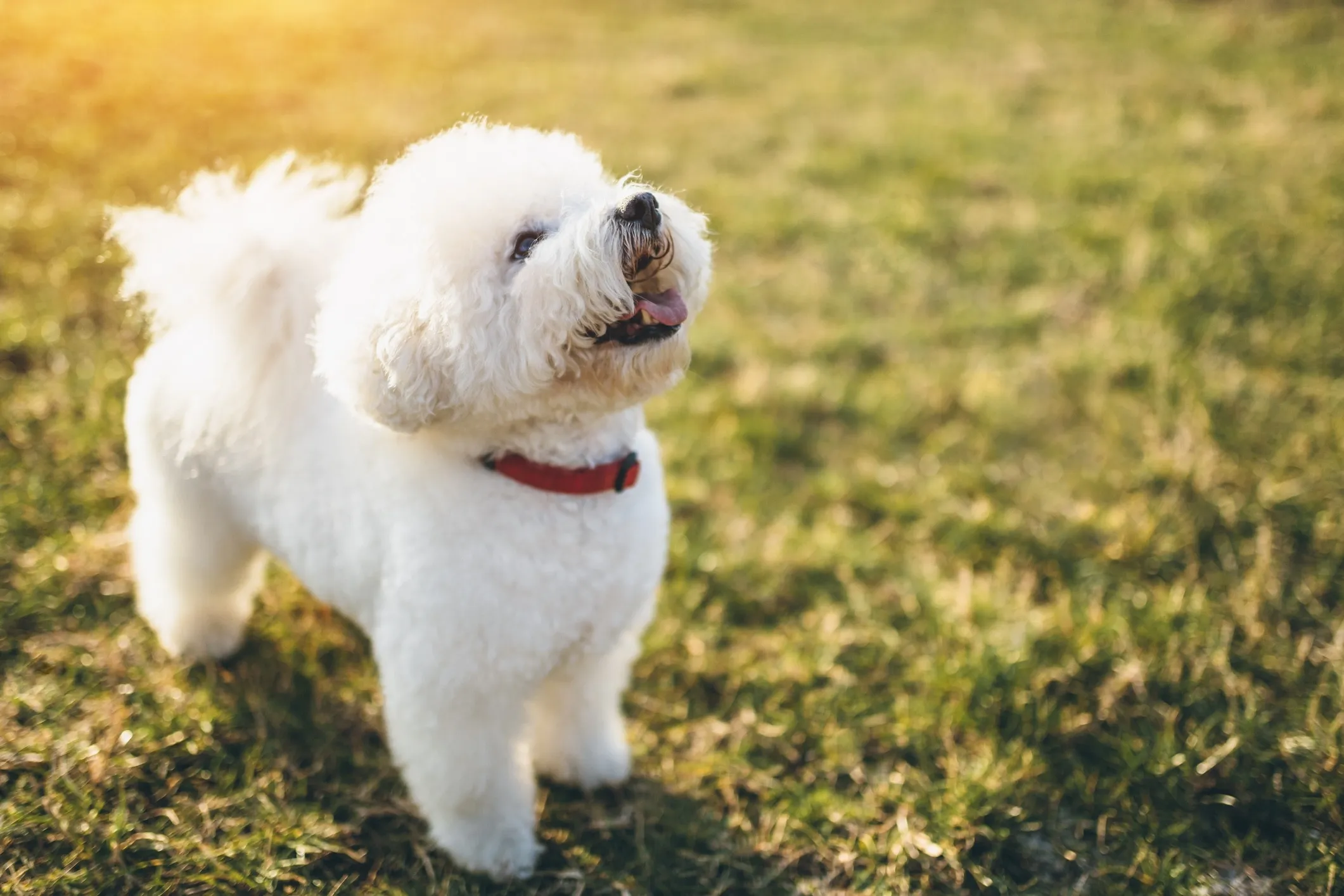 White Bichon Frise dog looking up in the grass
White Bichon Frise dog looking up in the grass
8. Chinese Crested
The Chinese Crested is a unique small breed known for its distinctive appearance and minimal shedding. They come in two varieties: hairless, with tufts of hair on the head, tail, and paws, and powderpuff, covered in long, silky hair. Both varieties are considered hypoallergenic. Chinese Cresteds are playful, affectionate, and make wonderful companion dogs, forming strong bonds with their families. Their loving nature and adaptability make them suitable for families seeking a devoted and unique pet. The hairless variety requires skin care to protect from sun and cold, while powderpuffs need regular grooming to prevent matting.
9. Portuguese Water Dog
Originally bred to assist fishermen, Portuguese Water Dogs are medium-sized, active, and intelligent. Their thick, curly, waterproof coat is low-shedding, making them a popular choice for families. These dogs are highly trainable, friendly, and possess a boundless energy that needs to be channeled through regular exercise. They excel in activities like swimming, retrieving, and agility. Their playful and devoted nature makes them excellent family members, especially for active families who enjoy outdoor adventures and can provide consistent training and mental stimulation. This breed, known for its water retrieving abilities, might also be suitable for families who enjoy activities like best bird hunting dogs for families, provided they are appropriately trained for such roles.
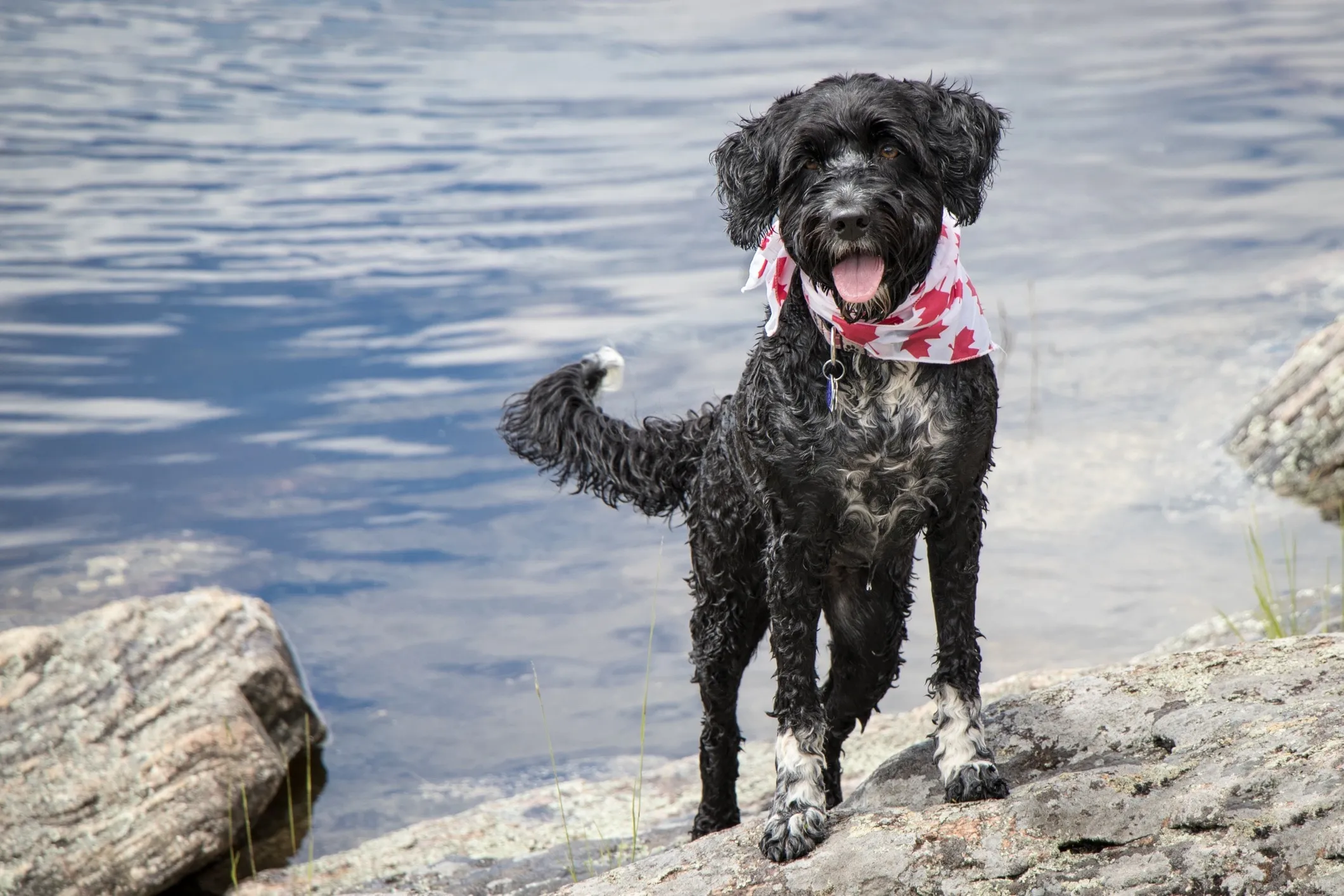 Black and white Portuguese Water Dog wearing a red maple leaf bandana in front of water
Black and white Portuguese Water Dog wearing a red maple leaf bandana in front of water
10. Labradoodle
A popular crossbreed between a Labrador Retriever and a Poodle, the Labradoodle was initially bred to be a hypoallergenic service dog. They are intelligent, friendly, and renowned for being excellent family pets. Labradoodles typically have a low-shedding coat (though coat types can vary) and inherit the Poodle’s intelligence and the Labrador’s amiable nature. They are highly trainable and generally gentle, making them wonderful companions for children and other pets, especially when socialized from an early age. These active dogs require regular exercise and mental engagement to thrive.
11. Goldendoodle
Another beloved “doodle” breed, Goldendoodles are a cross between a Golden Retriever and a Poodle. Like Labradoodles, they are cherished for their low-shedding coats, friendly nature, and high intelligence. Goldendoodles are typically outgoing, affectionate, and patient, making them superb family dogs. While many are known for their golden coats, they come in a variety of colors and textures. Regular grooming is essential to keep their coats free of mats. Their playful and loving disposition ensures they integrate seamlessly into family life, enjoying playtime and cuddles alike.
12. Lagotto Romagnolo
Originating in Italy, Lagotto Romagnolo dogs were bred as water retrievers, with their curly, woolly coats protecting them from cold waters. While less common, these charming dogs are low-shedding and can be excellent family pets, known for being good with children and other animals. They are intelligent, energetic, and eager to please, thriving on mental and physical activities. Their affectionate nature makes them devoted companions. For families seeking a unique, active, and non-shedding dog with a rich history, the Lagotto Romagnolo is a worthy consideration.
13. Affenpinscher
Affenpinschers are small dogs with a distinctive monkey-like appearance. Their dense, wiry coat sheds minimally, classifying them as hypoallergenic. These charming and confident little dogs are known for their playful and mischievous personalities. They form strong bonds with their families and can be good companions for older, respectful children. While small, they are lively and require regular playtime and attention. Their coat needs consistent care, including at-home brushing and occasional hand-stripping, to maintain its condition.
14. Irish Water Spaniel
The Irish Water Spaniel is a medium-to-large breed known for its distinctive curly, liver-colored coat that sheds very little. These intelligent, friendly, and highly trainable dogs were originally bred for retrieving game from water, making them an excellent choice for active families. They possess a high energy level and require substantial daily exercise to stay happy and healthy, such as long walks, swimming, or active play. Their playful nature and devotion to family make them engaging companions, especially for those who appreciate a dog with a sense of humor and a love for the outdoors. This breed’s heritage in retrieving game could also connect to resources on best dog breed for pheasant hunting.
15. Aussiedoodle
A cross between an Australian Shepherd and a Standard or Miniature Poodle, the Aussiedoodle is a highly intelligent and energetic non-shedding dog. These dogs inherit smarts from both parent breeds and are known for their lively and affectionate personalities. Aussiedoodles thrive on activity and mental stimulation; without enough, they can become bored and potentially destructive. They are generally good with children and other pets, making them suitable for active families who can provide consistent exercise, training, and enrichment toys. Their coat type can vary, but typically they are low-shedding and require regular grooming.
16. Bolognese
Hailing from Italy, the Bolognese is a small, playful, and easygoing dog with a long, fluffy white coat that is low-shedding. Despite its characteristic messy appearance, this coat requires consistent grooming. Bolognese dogs are known for their charming personalities and gentle demeanor, making them excellent family pets that get along well with children and other animals. They are highly adaptable and can fit into various living situations, provided they receive ample companionship and affection from their human family.
17. Maltese
The Maltese is a small, elegant dog renowned for its luxurious, silky white coat that sheds minimally. These affectionate and playful companions thrive on human interaction and make devoted family members. Maltese are generally good with children and other pets, provided they are introduced properly and handled gently due to their delicate size. Their long coat requires dedicated grooming to prevent tangles and mats, though many owners opt for a shorter “puppy cut” to simplify maintenance. Their charming personality and low-shedding nature make them a delightful addition to many families.
 Woman holding a white Maltese dog on a bed
Woman holding a white Maltese dog on a bed
18. Soft Coated Wheaten Terrier
The Soft Coated Wheaten Terrier is a medium-sized Irish breed famous for its silky, soft, wheat-colored coat that sheds very little. True to their terrier heritage, Wheatens are energetic, joyful, and maintain a high activity level throughout their lives. They are known for their affectionate “Wheaten Greetin'” where they jump up to welcome their family. Wheatens make wonderful family dogs, good with children and active companions. They require ample exercise and mental stimulation to keep their playful spirits happy and to ensure they are on their best behavior.
19. Coton de Tulear
Originating from Madagascar, the Coton de Tulear is a small, easygoing, and incredibly charming dog. Their soft, cotton-like coat is low-shedding and relatively easy to maintain with regular brushing. Cotons are known for their good-natured temperament, making them an excellent fit for families with children and other pets, especially when proper introductions are made. They are playful yet adaptable, equally happy to join in family games or cuddle on the couch, thriving on companionship and affection.
20. Schnoodle
The Schnoodle is a delightful crossbreed combining two non-shedding powerhouses: the Schnauzer and the Poodle. This mix results in a low-shedding dog with a coat that can be curly or wavy, depending on genetic inheritance. Schnoodles are intelligent, playful, and affectionate, inheriting desirable traits from both parent breeds. They are versatile and can be suitable for various family settings, enjoying both active play and quiet time with their humans. Their intelligence makes them highly trainable, and their agreeable nature generally makes them good with children and other animals.
21. Bedlington Terrier
Often described as a “lamb in dog’s clothing,” the Bedlington Terrier is a small, curly-haired breed recognized by its distinctive topknot and pom-pom ear tufts. Their unique woolly coat sheds minimally. Bedlingtons are known for their gentle and loving nature, forming strong bonds with their families. They enjoy being close to their people and can be prone to separation anxiety if left alone for extended periods. This breed is playful and spirited, requiring daily exercise. For families seeking a unique, affectionate, and low-shedding companion, the Bedlington Terrier is a charming choice.
22. Xoloitzcuintli
Also known as the Mexican Hairless Dog, the Xoloitzcuintli (pronounced Sho-lo-eets-kweent-lee) is one of the oldest and rarest dog breeds. They come in three sizes (toy, miniature, and standard) and can be hairless or have a short, fine coat. Both varieties are hypoallergenic due to their minimal hair and shedding. Xolos are known for being calm, loyal, and watchful, forming a strong bond with their families. They are generally good with children, especially when socialized from a young age. Their unique appearance and ancient lineage make them a fascinating and loving family member.
23. Whoodle
The Whoodle is a friendly crossbreed resulting from a Soft-Coated Wheaten Terrier and a Poodle. These dogs inherit intelligence and an affectionate nature from both parent breeds, along with a low-shedding coat. Whoodles are playful, outgoing, and form strong bonds with their families. They are generally good with children and other pets, thriving on companionship and activity. Their energetic disposition means they require regular exercise and mental stimulation to remain happy and well-adjusted, making them ideal for active families.
24. Bernedoodle
Bernedoodles are a cross between a Bernese Mountain Dog and a Poodle. These large, affectionate dogs combine the gentle demeanor of the Bernese with the intelligence and low-shedding coat of the Poodle. Bernedoodles are known for their friendly, outgoing nature, making them incredibly popular with families, especially those with children and other pets. They require plenty of exercise to stay active and happy, enjoying outdoor adventures and playtime. Their loyalty and amiable temperament make them fantastic, cuddly companions for a wide range of family dynamics.
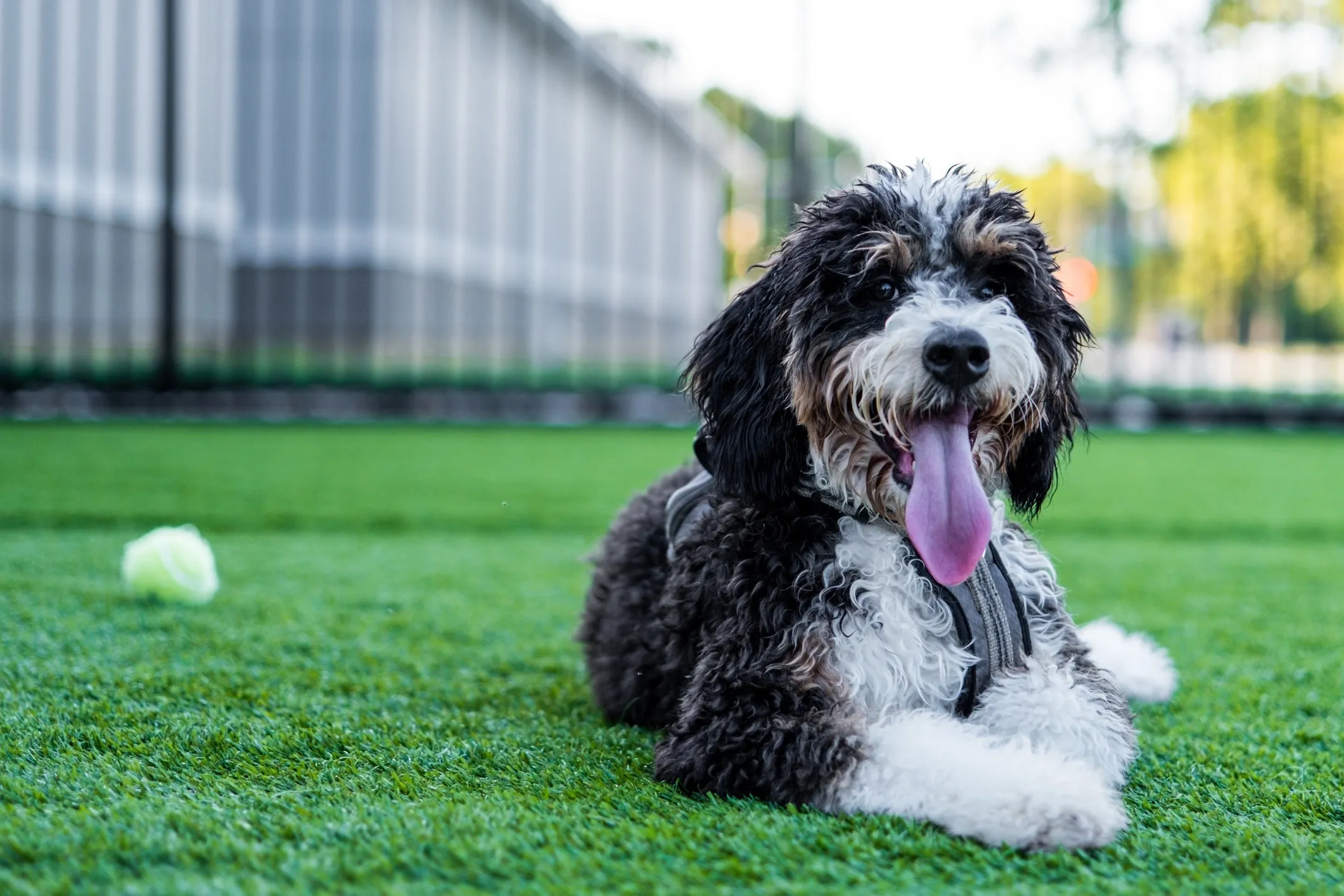 Large Bernedoodle dog lying in grass with his tongue out
Large Bernedoodle dog lying in grass with his tongue out
25. Shorkie
The Shorkie is a charming mixed breed, a cross between two non-shedding dogs: the Shih Tzu and the Yorkshire Terrier. These small dogs embody the best traits of both breeds—they are playful, friendly, and deeply affectionate. Shorkies are highly adaptable to various living situations and thrive on companionship, making them excellent lap dogs and family members. While their shedding is minimal, they require dedication to a regular grooming routine to keep their coats healthy and tangle-free. Their lively personality and compact size make them a delightful addition to families seeking a small, low-shedding companion.
26. Afghan Hound
Afghan Hounds are striking dogs, famous for their long, flowing coats and slender, elegant builds. Despite their voluminous hair, they are considered low-shedding. These majestic dogs are built for speed and possess a unique combination of aloofness with strangers and deep affection for their family. Early and consistent socialization is crucial for this breed to ensure they are well-adjusted in various social settings. Their independent nature and need for significant exercise make them best suited for experienced owners and active families who can appreciate their distinct personality and grooming requirements. The speed and agility of Afghan Hounds could also appeal to families interested in the black and white hunting dog breeds that sometimes exhibit similar athletic prowess.
27. Barbet
The Barbet, pronounced “bar-bay,” is a cheerful pup with a shaggy, woolly coat derived from the French word barbe meaning beard, a nod to their characteristic hairy chin. This big, non-shedding dog loves to swim, thanks to their protective curly coat. Barbets are known for their friendly, joyful disposition and are typically good with children and other pets, making them excellent family companions. They require regular brushing, two to three times a week, to keep their coat in good condition, especially after swimming adventures. Their active nature means they need consistent exercise and mental engagement.
28. Shih-Poo
A mixed breed combining a Shih Tzu and a Poodle (most often a Toy Poodle), the Shih-Poo is a small dog that can thrive in almost any living situation. These pups are affectionate, playful, and intelligent, inheriting desirable qualities from both parent breeds. Their coat is typically low-shedding, making them a good choice for families with allergy concerns. Shih-Poos require about 30 minutes of exercise daily and a good brushing session to keep their coats neat. Their adaptable and loving nature ensures they integrate well into family life, offering endless cuddles and entertainment.
29. Peruvian Inca Orchid
Peruvian Inca Orchids are a rare and ancient dog breed, notable for their nearly hairless bodies, which makes them hypoallergenic. They come in three sizes (small, medium, and large) and are the national dog of Peru. These unique dogs are known for being alert, noble, and deeply devoted to their families, though they can be reserved with strangers. Their calm demeanor and strong bond with their human companions make them suitable for families who appreciate a quiet, loving, and truly distinctive pet. Hairless varieties require special skin care to protect against sun and cold.
30. Malshi
The Malshi is a happy, small, non-shedding dog, a cross between the Maltese and Shih Tzu. These delightful pups thrive on close companionship and form strong attachments to their favorite humans. Malshis are known for their playful and affectionate personalities, making them excellent family pets. They are typically good with children and adapt well to various home environments, as long as they receive plenty of love and attention. Like most non-shedding breeds, they require a regular grooming routine to keep their beautiful coats healthy and free from mats.
Tips for Living with a Non-Shedding Dog in a Family
Bringing a non-shedding dog into your family can significantly improve the quality of life for individuals with allergies and lead to a cleaner home. However, it’s essential to implement a few key practices to minimize allergens further and ensure a happy, healthy environment for everyone.
Keep Up With Grooming
Even low-shedding dogs require consistent grooming. Regular brushing, ideally several times a week, helps to remove any trapped loose hair and dander from their coat before it can be released into the home. Bathing every four to six weeks is also crucial to keep their skin and coat clean and to wash away allergens. Using a specialized shampoo designed to reduce pet dander can be particularly beneficial. Many non-shedding breeds also require regular trimming or professional grooming appointments to maintain their coat’s health and appearance, so budget for this or learn to groom your pup at home.
Maintain a Clean House
A clean home is vital for minimizing allergens. Regular vacuuming with a HEPA filter vacuum cleaner, dusting surfaces, and washing bedding (both human and pet) frequently will help reduce the accumulation of pet dander. Utilizing air purifiers with HEPA filters and ensuring good ventilation throughout your home can also help to remove airborne allergens, creating a more comfortable living space for family members with sensitivities.
Talk to Your Doctor
If family members have severe allergies, it’s always advisable to consult with a healthcare provider or allergist. They can offer personalized advice on managing allergies, which might include medications, nasal sprays, or allergy injections. While non-shedding dogs reduce dander, it’s also important to minimize direct contact with a dog’s saliva and urine, as these also contain allergens. By combining the benefits of a low-shedding breed with proactive allergy management and a clean home, families can fully experience the joy and companionship that a dog brings without constant allergic reactions.
